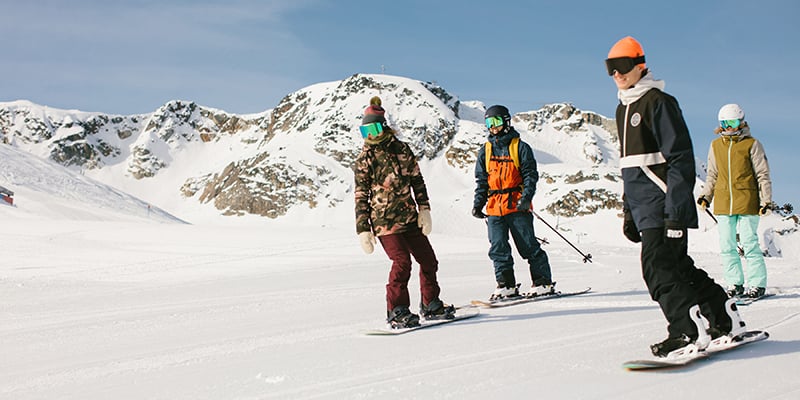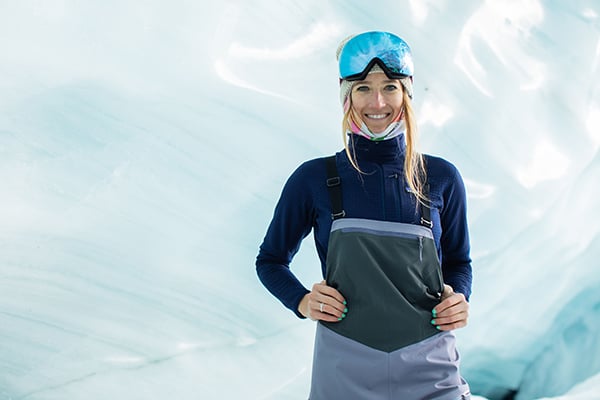How to Choose Ski & Snowboard Pants & Bibs
When you’re getting geared up for your day on the slopes, you might think first to your board and boots, but don’t forget about your ski pants - they’re one of the most important pieces of winter gear. Whether you’re making your fist turns, or working on the mountain day-in and day-out, you’re going to need to rely on your ski & snowboard pants to keep you warm and dry. With pricetags tags that soar quickly, and a host of different materials and technologies, choosing the right ski & snowboard pants can be confusing. The most important things to consider are the technical stats like waterproofing, insulation, and if you want pants or bibs. So drop in with us, and we’ll break down everything that you need to know to buy the best ski & snowboard pants for you.

Ski & Snowboard Pants vs Bibs
If you’re shopping for new ski or snowboard pants, the very first question to ask yourself is: do you actually want pants? Of course you do, right!? Wrong! It’s not that simple. While many skiers and snowboarders search for pants by default, it’s always worth considering getting a pair of bibs instead. Ski and snowboard bibs have several big advantages over pants: they do a better job of keeping snow out, they have more storage options, and they fit more body shapes more comfortably.
On the flipside, sometimes bib straps can interfere with the straps on your backpack and make it rub a little, and if you’re swapping layers a lot, bibs can get in the way of that.
If you’ve never tried skiing or snowboarding in bibs, we highly recommend it, they work with your jacket to make it impossible for snow to get up your back or down your pants, and suspending your pants from your shoulders, instead of cinching them at the waist makes then much more comfortable and gives you a wider range of motion. And new bibs have strategic zippers to make answering nature’s call easier without having to pull them down. But no matter whether you decide to go with bibs or pants, there are a few design features and options to keep in mind as you’re shopping.
Ski & Snowboard Pants Waterproofing
The biggest differentiator between ski and snowboard pants is their waterproofing. More waterproof pants often feature nicer materials that are often more expensive. This means that choosing the right ski & snowboard pants comes down to finding the right balance between cost and performance.
Ski & snowboard pants waterproofing is measured in units of thousands, so a pant that is 20K waterproof is more waterproof than a 10K rated pair of pants. Manufacturers can use a variety of materials to achieve that waterproofing rating, including membranes like GORE-TEX. But no matter what material is being used, that waterproofing rating is the best indicator of how dry your pants will keep you. We recommend ski and snowboard pants with at least a 10k waterproof rating. If you often run into wetter conditions like in the PNW, or if you like to ride through even the nastiest conditions look for pants with at least a 20K waterproof rating. Some high-end fabrics will not have a numeric rating listed. You can do your own research here, or trust that they’d rate at least 20k.
Ski & Snowboard Pants Breathability
The second technical stat that can help guide your ski and snowboard pants choice is breathability. Skiing or snowboarding is a lot of work, and when we exercise, we sweat. Breathable pants let that sweat evaporate, instead of keeping it close to your skin where it will freeze and make you clammy. Breathability is measured in a similar way to waterproofing, in thousands, and usually goes hand-in-hand with waterproofing. This means if you get nice ski and snowboard pants with a great waterproof rating, they’ll likely be nice and breathable, too. If you generally ride chairlifts and rarely hike or skin, a 10K breathability will be just fine. If you tend to get sweaty a lot, or you like to earn your turns, look for a higher breathability rating, like 20k.
Insulated vs Shell Ski & Snowboard Pants
Aside from the technical weatherproofing stats, theres one more major decision to make - do you want shell ski and snowboard pants, or insulated ones? While many ski and snowboard pants are just shells with no warmth components, there are plenty of insulated options as well. Insulated ski pants make a lot of sense for riders who spend most of their time riding chairlifts in colder parts of the world. The priority with insulation is always to keep your core warm, but if you have run into trouble with your legs getting cold in the past, insulated pants may be the right call for you.
If your legs don’t get cold easily you’re best served by a shell pant. Shell pants are a little more versatile, you can wear them with just your underwear underneath when it’s warm out, and stack a few base layers underneath when it’s cooler.
If you decide that insulated pants are right for you, there are a couple of things to consider. Insulation is measured in grams per square meter, and the higher the number the warmer it will keep you. Some pants are insulated all the way through the whole shell, while others just have insulated zones around the bottom and thighs of the pants to keep you warm on the chairlift.
Ski & Snowboard Pants Fit
Finally, the last part of the pants equation is fit, along with style, this is the most personal aspect - the fit of your pants isn’t going to affect their performance as long as they’re not limiting your mobility. On the note of mobility, it’s important to remember that you’ll often be wearing your pants with baselayers, and sometimes even a midlayer, too. So either try on the pants with your underlayers, or make sure you’ll have room to maneuver. If you do want to look for a skinnier or tighter fit, look for ski and snowboard pants with some stretch.
Most pants will have their fit listed, this can help you avoid the surprise of skinny pants showing up on your doorstep before your big ski trip. Likewise, you can read reviews to fins out how a particular pair of ski and snowboard pants or bibs might fit your body type.
Long & Tall Ski and Snowboard Pants
For skiers and snowboarders that have different body dimensions, some manufacturers make extended sizes. If this sounds like you, make sure to keep your eye out for “long” or “tall” variations of different pants. Reviews and feedback from other riders can help you find the best fit here, too.
Ski & Snowboard Pants Features
Pockets
The most obvious feature of pants is pockets. Think about how much gear you want to carry in your ski pants, and then look at various pocket layouts, which ones make the most sense to you? Zippered pockets are always more secure than button or velcro pockets, so make sure any pocket you’d put valuables in has a zipper. Bibs are nice because they’ve got even more pockets up in the chest area that also stay warm, so they’re great for things like your cell phone. If you’re backcountry skiing or riding, look for pants with a dedicated beacon pocket. It will keep your beacon more handy than wearing it on a harness, and makes it easier to use.
Vents
If you’re hiking uphill, or even just skiing on a warm spring day, your pants can start to overheat in even the most breathable pants. To help with this, most pants and bibs come with zippered vents to help you dump heat. Usually these are on either the inside, or the outside of the thigh. Both styles of vents work, and pants with vents on both the inside and outside can get a nice cross breeze going. If you plan on skiing with your vents open a lot, look for ones with a mesh lining to keep the snow out of your pants.
Cuffs
The interface between your pants and your boots is a prime place for snow to work its way into your boots. So look for pants with an elastic inner cuff with rubber grippers. You can pull this cuff down over the boot so that it locks the pant down and keeps snow out. Do not ever wear this cuff inside the boot, it will be uncomfortable. Some snowboard pants have a cuff with a hook that loops onto the laces and holds the cuff down.
Kick Patches
The most common place for pants to wear out is around the cuff where your boots and ski edges smack against the fabric. Good pants will have reinforced material here to help protect against cuts and tears. If you’re hard on your gear, these are a must have, making your pants last longer.

What to Wear Under Ski Pants
Finally, once you’ve figured out what you’re looking for in a pair of snow pants, there’s one more important question: what should you wear underneath ski and snowboard pants? It’s easier to say what you shouldn’t wear as a base layer, and that’s anything cotton. Cotton boxers, base layers, or sweatpants are a recipe for a sweaty, clammy, uncomfortable day on the slopes. Instead look for a wool or synthetic base layer that doesn’t interfere with your boots. You can get a thicker layer for cold days, or just wear your (non-cotton) underwear underneath on warmer days. Leggings are okay to wear under your snow pants, but they won’t be as warm as true baselayers, and they can interfere with your boots if they’re too tight and you can’t roll them up.
Learn More With Our Other Outerwear & Layering Guides:
What to Wear Skiing & Snowboarding
How to Choose a Ski & Snowboard Jacket
How to Choose Ski & Snowboard Pants
Jacket Fit & Length Guide
How to Choose Outerwear by Region
How to Dress for Backcountry Skiing & Snowboarding
Waterproof Ratings & Breathability Guide
Outerwear Construction, Fabric & Features
How to Choose Base Layers & Long Underwear
How to Choose Insulated Clothing
GORE-TEX® Fabric - How it Works & Product Testing
